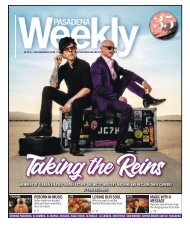Create successful ePaper yourself
Turn your PDF publications into a flip-book with our unique Google optimized e-Paper software.
–continued from page 27<br />
(Top and bottom): Function<br />
and Fitness clients; (above<br />
right) Functional Fitness<br />
client with Tom Strafaci;<br />
(below right) Brandon<br />
Flowers and Rick Caputo<br />
Finally armed with our workout regimen, Coach Jess leads us in a<br />
warm-up before beginning a 45-minute routine specifically crafted<br />
to target common movements and muscle groups that assist us<br />
in our daily lives. It’s sweaty, exhausting, challenging and,<br />
yes, I’ll admit it, fun.<br />
The motto “Train Movements, Not Muscles” is displayed<br />
on the wall, a subtle reminder that this place — like a growing<br />
number of fitness facilities — embraces a functional fitness training<br />
concept that doesn’t promise you six-pack abs or deeply chiseled<br />
biceps. Your reward is being able to easily master a flight of steps, effortlessly<br />
squat down to pick up a dropped iPhone and comfortably place<br />
your carry-on luggage in the overhead bin.<br />
Indeed, functional fitness has hit the mainstream. Self magazine calls it<br />
one of the “Ten Biggest Fitness Trends of 2018,” but many coaches, devotees<br />
and others in the fitness industry say this workout method has been around for<br />
years — there’s just a new light shining on it.<br />
Maybe the heightened attention comes from aging Baby Boomers who want to<br />
stay in shape but don’t strive to be super hard-core athletes. According to the Mayo<br />
Clinic, “This type of training, properly applied, can make everyday activities easier,<br />
reduce your risk of injury and improve your quality of life…. [It can help] older adults<br />
improve balance, agility and muscle strength, and reduce the risk of falls.”<br />
According to Christine Clark, owner of Function and Fitness, there are six main functional<br />
movements that are usually incorporated into her facility’s workouts: squats, lunges, rotations,<br />
hip hinging, pushing and pressing. “What we do is teach basic patterns of movements because<br />
every day we push, every day we pull, every day we lunge, hinge and squat. Our hope is that you take<br />
the stuff you learn here and apply it outside — at work, at home, the store, wherever — so you can<br />
stay healthy and safe.” Clark explains that the idea is to prevent the type of injuries most people suffer,<br />
usually from doing something as mundane as putting groceries in the car. “People typically throw out their<br />
backs because they haven’t strengthened those rotational movements,” she adds.<br />
Today, all of Clark’s exercise classes are led by coaches who supervise the carefully programmed weekly<br />
small and large group sessions that build upon the prior week.<br />
Clark started her fitness career as an instructor at a big-box gym and then met clients in rental spaces until she<br />
opened up this workout facility in 2014. At fitness conferences, she sees new expensive equipment for sale and crazy<br />
workout techniques. “But you won’t see any of them the next year because they didn’t catch on. You know what works?<br />
Good old-fashioned dumbbells, kettlebells and resistance training.”<br />
Indeed, the power of functional training is vital as we age, contends Tom Strafaci, owner of Functional Fitness, which<br />
has locations in Monrovia and Arcadia. Most of Strafaci’s clients are older — and many come to the facility “fearful of<br />
movement,” he says. “Often simple things, like climbing stairways, getting into a car or using the toilet can be difficult for<br />
older people,” he says. Strafaci and his coaching staff train one-on-one for a more personalized exercise session. They know their<br />
clients’ backstories; many have diabetes or knee replacements or a history of heart attacks and strokes.<br />
“Sometimes a good workout that day doesn’t mean sweating like crazy,” he says of his individualized approach. “Maybe it’s a<br />
series of eye drills to help with balance because that function is way off that day. We meet clients where they are at that moment.<br />
Our goal is to train clients so they can maintain their independence.”<br />
With more than 34 years in the world of fitness (including a previous career as a physical therapist), Strafaci has seen many fads<br />
come and go, but he’s excited about one of the industry’s newest trends. “It’s not a piece of equipment,” he explains. “It’s better-<br />
28 | ARROYO | 01.19

















